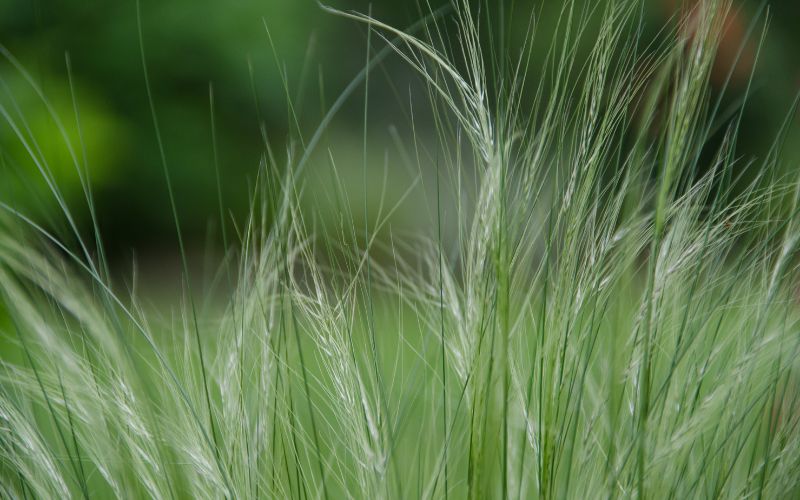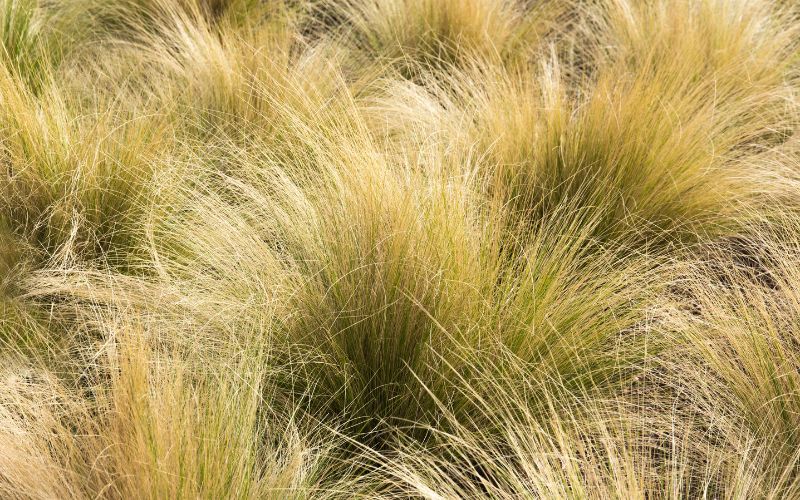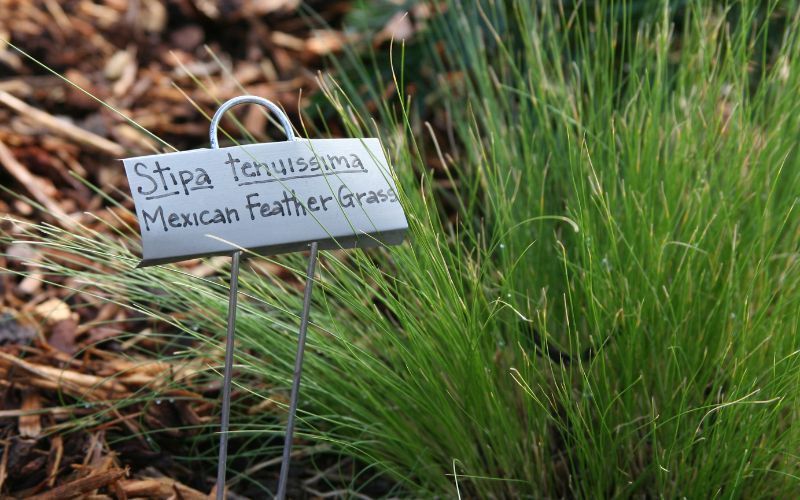Mexican feather grass is a beautiful, ornamental grass that adds a touch of the southwest to any landscape.
It is drought tolerant and can withstand hot, sunny conditions, making it a perfect choice for those who live in dry climates.
Mexican feather grass is easy to care for and can be propagated easily from seed. Read on to learn more about how to care for Mexican feather grass.
Mexican feather grass enjoys a sunny location in a well draining, sandy soil. Water well during the first growing season to help the plant to develop and fertilise in early Spring. Leave the grass to turn dormant in winter and it will grow back strongly in the next growing season.
What is Mexican feather grass?
Mexican feather grass (Stipa tenuissima) is a versatile, drought-resistant ornamental grass that is native to the arid regions of Mexico and the southwestern United States.
Mexican feather grass gets its name from its fine, hair-like foliage that resembles feathers.
The leaves of the plant are a light green in color and grow in tufts from the base of the plant.
The plant produces small, reddish-brown flowers in summer that turn into seeds that are prized by birds.
Mexican feather grass is a low-maintenance plant that requires little water or fertilizer once it is established.
It grows best in full sun and sandy, well-drained soils.
Mexican feather grass can be used as an accent plant, mass planted, or grown in containers. It is also deer resistant.
How to care for Mexican feather grass
Mexican feather grass is drought-tolerant and prefers full sun, making it an ideal plant for hot, dry climates. It can be planted in USDA hardiness zones 6-10.
To care for Mexican feather grass, water it deeply and regularly during the first growing season to help establish a strong root system.
Once it is established, it is relatively drought-tolerant and does not need much supplemental watering.
In fact, too much water can cause the roots to rot.
Fertilize Mexican feather grass once a year in early spring with a balanced fertilizer.
Cut the grass down to 3-4 inches in late winter or early spring before new growth begins.
And finally, Mexican feather grass is fairly resistant to pests and diseases, but it can be susceptible to rust if grown in wet conditions.

When to water Mexican feather grass
When watering Mexican feather grass, it is important to keep the following factors in mind.
First, this type of is not totally drought tolerant, so it is important to water it regularly during periods of dry weather.
Second, Mexican feather grass prefers to be watered early in the day so that the leaves have time to dry before nighttime temperatures drop.
Mexico feather grass will go dormant in the winter, so there is no need to water it during this time.
Allow the soil to dry out between watering. Too much water will cause the roots to rot.
Finally, this type of grass is relatively tolerant of salt, so it can be watered with lightly salted water without fear of damaging the plant.
How much sun does Mexican feather grass need?
Mexican feather grass thrives in hot, sunny conditions
While it can tolerant of some shade, Mexican feather grass will produce the best growth and flowering if it is grown in full sun.
If you live in an area with hot summers, this grass is a great choice for adding color and interest to your garden with minimal maintenance.
What kind of soil does Mexican feather grass need?
Mexican feather grass grows best in sandy or gravelly soils that are well-drained.
It is tolerant of drought and can even grow in very dry conditions.
When grown in rich soils, Mexican feather grass can become invasive.
Therefore, it is best to plant this grass in an area where it will not spread beyond its desired location.
[amazon box=”B004N8I188″ template=”horizontal” description=” “]
Does Mexican feather grass need fertilizer?
Although this grass is highly tolerant of poor soil conditions, it will benefit from occasional fertilization.
A slow-release fertilizer applied in early spring will help Mexican feather grass to grow thick and lush.
For best results, follow the manufacturer’s directions on the package.
Pests and diseases that can affect Mexican feather grass
Like many plants Mexican feather grass can be susceptible to a number of pests and diseases, which can cause significant damage.
One of the most common problems is rust (Puccinia megacarporae), which causes orange-red pustules to form on the leaves.
This can lead to leaf loss and reduced plant vigor.
Mexican feather grass is also susceptible to root rot (Phymatotrichum omnivorum), which can kill the plant outright.
To prevent these problems, it’s important to choose a healthy plant from a reputable nursery, and to provide proper care (including watering, fertilizing, and clipping).
How to propagate Mexican feather grass
Mexican feather grass is easily propagated from seed or division.
Seed propagation is the easiest and most common method unless you already have a plant which can be divided.
To propagate Mexican feather grass from seed, simply sow the seeds in a pot or tray of moistened potting mix.
Cover the pot or tray with plastic wrap to help retain moisture and place it in a warm, sunny location.
Keep the potting mix moist but not soggy, and within a few weeks you should see new seedlings emerging.
Once the seedlings are large enough to handle, transplant them into individual pots or into their permanent location in the landscape.
For division, wait until early spring when the plant is actively growing.
Use a sharp knife or spade to carefully divide the rootball into smaller clumps, making sure that each clump has a good portion of roots attached.
Plant the divisions immediately in their permanent location and water well to help them get established.

Using Mexican feather grass in landscaping
Mexican feather grass is an ideal plant for use in rock gardens, on slopes, or in other areas where water conservation is important.
In addition to its aesthetic value, Mexican feather grass is also highly beneficial to the environment.
The deep roots of the plant help to prevent soil erosion, and the leaves provide food and shelter for birds and other wildlife.
Mexican feather grass is an attractive and versatile plant that can add beauty and interest to any landscape.
Final Words
Mexican feather grass is a great choice for adding color and interest to your garden with minimal maintenance.
It thrives in hot, sunny conditions and is tolerant of drought.
It grows best in sandy or gravelly soils that are well-drained and can even grow in very dry conditions.
Although it is highly tolerant of poor soil conditions, it will benefit from occasional fertilization.
Mexican feather grass is easily propagated from seed or division, and can be used in landscaping to prevent soil erosion and provide food and shelter for birds and other wildlife.






